2805NRS - Analyzing Legal and Ethical Principles in Healthcare Cases
VerifiedAdded on 2023/06/15
|10
|2963
|383
Case Study
AI Summary
This case study delves into the legal and ethical dilemmas within a healthcare scenario, focusing on principles like autonomy and beneficence. It examines the elements of informed consent, the role of QCAT in decision-making, and conflicts between patient wishes and medical opinions. The analysis considers a situation where a patient's refusal of treatment clashes with the necessity of medical intervention, and the subsequent challenges in determining the best course of action when stakeholders have conflicting values. The essay also refers to Kerridge's modified model for solving ethical issues, emphasizing the importance of patient-centered care and advanced medical assessments. Desklib provides a platform for students to access similar case studies and resources for academic support.
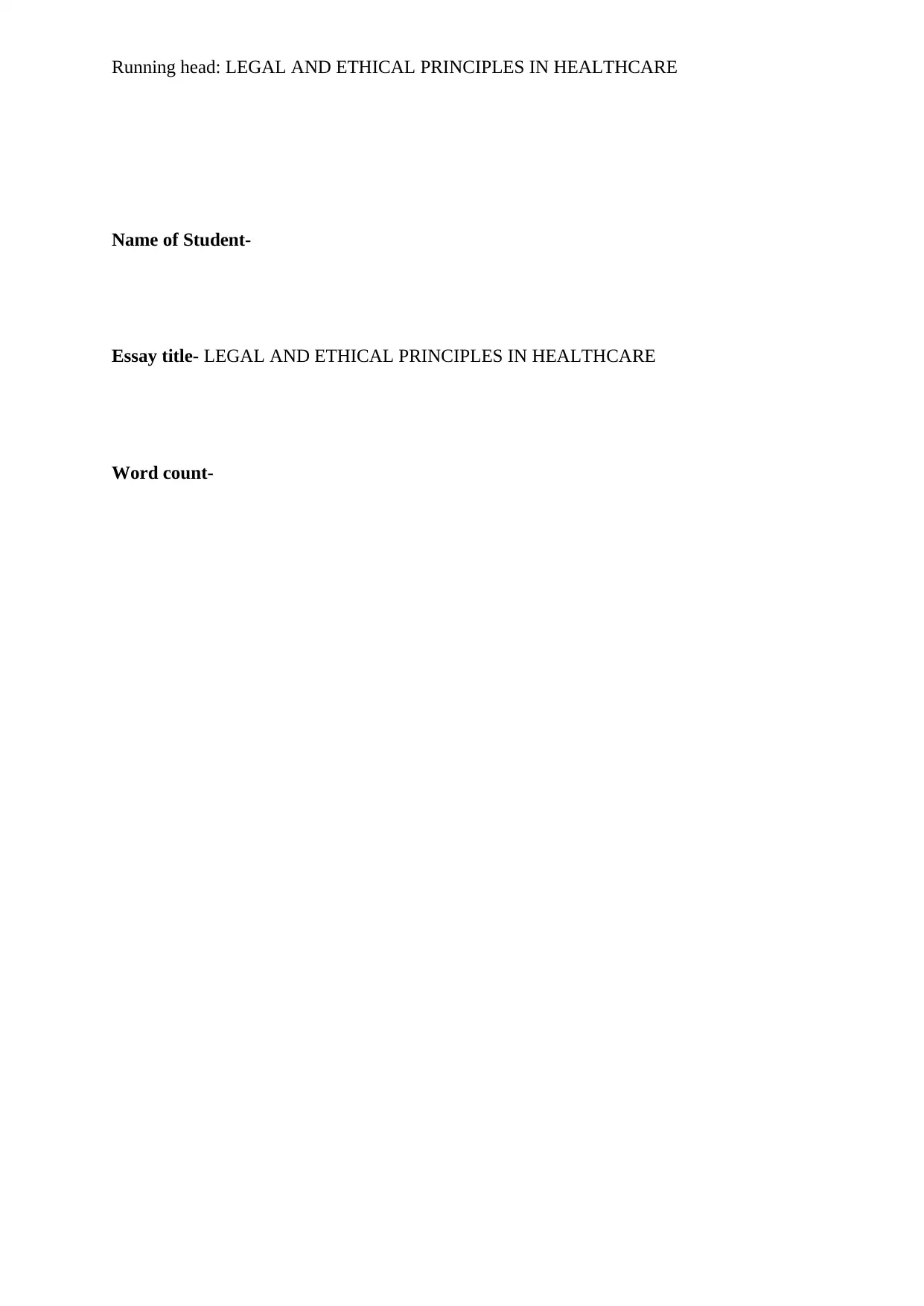
Running head: LEGAL AND ETHICAL PRINCIPLES IN HEALTHCARE
Name of Student-
Essay title- LEGAL AND ETHICAL PRINCIPLES IN HEALTHCARE
Word count-
Name of Student-
Essay title- LEGAL AND ETHICAL PRINCIPLES IN HEALTHCARE
Word count-
Paraphrase This Document
Need a fresh take? Get an instant paraphrase of this document with our AI Paraphraser
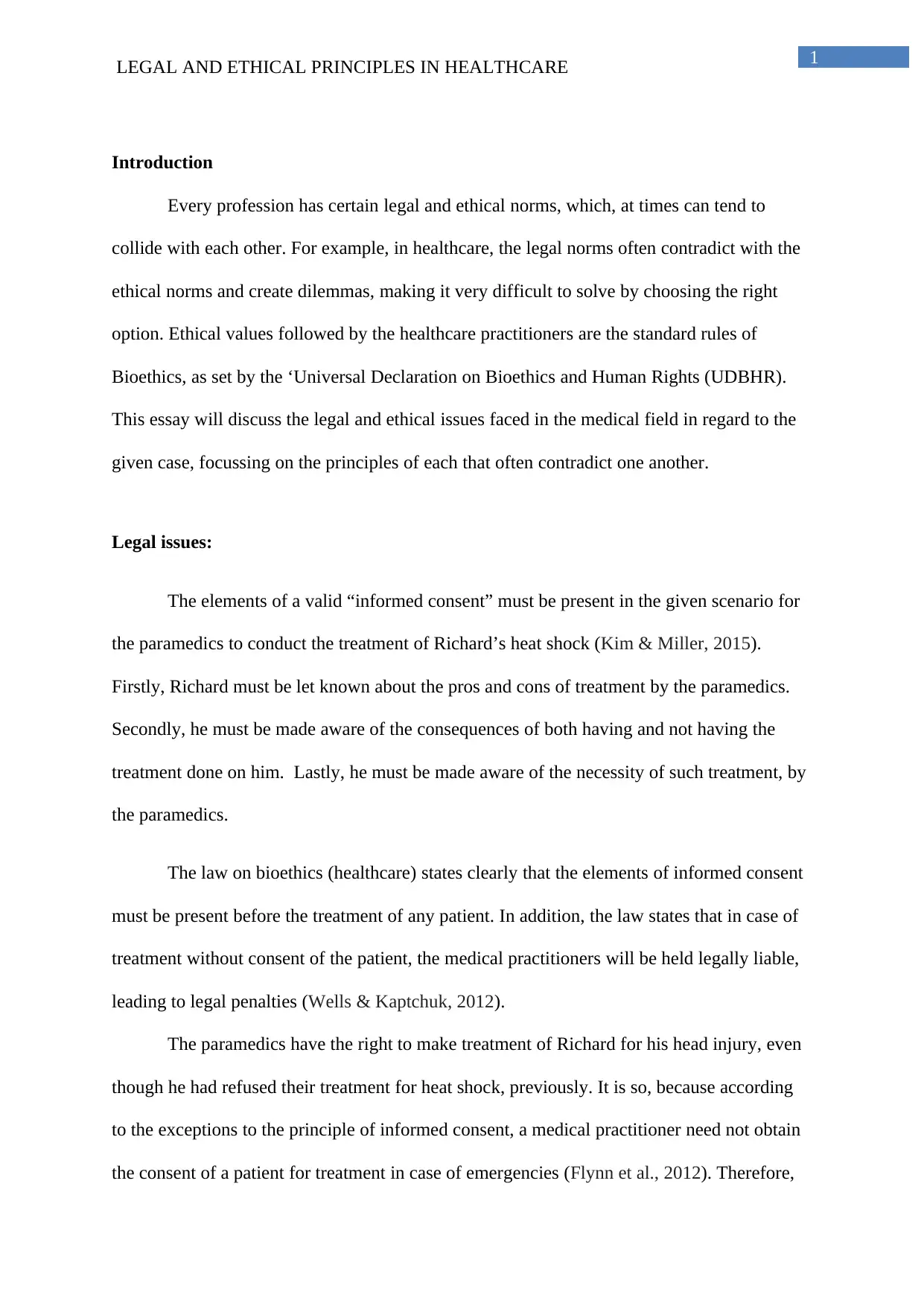
1
LEGAL AND ETHICAL PRINCIPLES IN HEALTHCARE
Introduction
Every profession has certain legal and ethical norms, which, at times can tend to
collide with each other. For example, in healthcare, the legal norms often contradict with the
ethical norms and create dilemmas, making it very difficult to solve by choosing the right
option. Ethical values followed by the healthcare practitioners are the standard rules of
Bioethics, as set by the ‘Universal Declaration on Bioethics and Human Rights (UDBHR).
This essay will discuss the legal and ethical issues faced in the medical field in regard to the
given case, focussing on the principles of each that often contradict one another.
Legal issues:
The elements of a valid “informed consent” must be present in the given scenario for
the paramedics to conduct the treatment of Richard’s heat shock (Kim & Miller, 2015).
Firstly, Richard must be let known about the pros and cons of treatment by the paramedics.
Secondly, he must be made aware of the consequences of both having and not having the
treatment done on him. Lastly, he must be made aware of the necessity of such treatment, by
the paramedics.
The law on bioethics (healthcare) states clearly that the elements of informed consent
must be present before the treatment of any patient. In addition, the law states that in case of
treatment without consent of the patient, the medical practitioners will be held legally liable,
leading to legal penalties (Wells & Kaptchuk, 2012).
The paramedics have the right to make treatment of Richard for his head injury, even
though he had refused their treatment for heat shock, previously. It is so, because according
to the exceptions to the principle of informed consent, a medical practitioner need not obtain
the consent of a patient for treatment in case of emergencies (Flynn et al., 2012). Therefore,
LEGAL AND ETHICAL PRINCIPLES IN HEALTHCARE
Introduction
Every profession has certain legal and ethical norms, which, at times can tend to
collide with each other. For example, in healthcare, the legal norms often contradict with the
ethical norms and create dilemmas, making it very difficult to solve by choosing the right
option. Ethical values followed by the healthcare practitioners are the standard rules of
Bioethics, as set by the ‘Universal Declaration on Bioethics and Human Rights (UDBHR).
This essay will discuss the legal and ethical issues faced in the medical field in regard to the
given case, focussing on the principles of each that often contradict one another.
Legal issues:
The elements of a valid “informed consent” must be present in the given scenario for
the paramedics to conduct the treatment of Richard’s heat shock (Kim & Miller, 2015).
Firstly, Richard must be let known about the pros and cons of treatment by the paramedics.
Secondly, he must be made aware of the consequences of both having and not having the
treatment done on him. Lastly, he must be made aware of the necessity of such treatment, by
the paramedics.
The law on bioethics (healthcare) states clearly that the elements of informed consent
must be present before the treatment of any patient. In addition, the law states that in case of
treatment without consent of the patient, the medical practitioners will be held legally liable,
leading to legal penalties (Wells & Kaptchuk, 2012).
The paramedics have the right to make treatment of Richard for his head injury, even
though he had refused their treatment for heat shock, previously. It is so, because according
to the exceptions to the principle of informed consent, a medical practitioner need not obtain
the consent of a patient for treatment in case of emergencies (Flynn et al., 2012). Therefore,
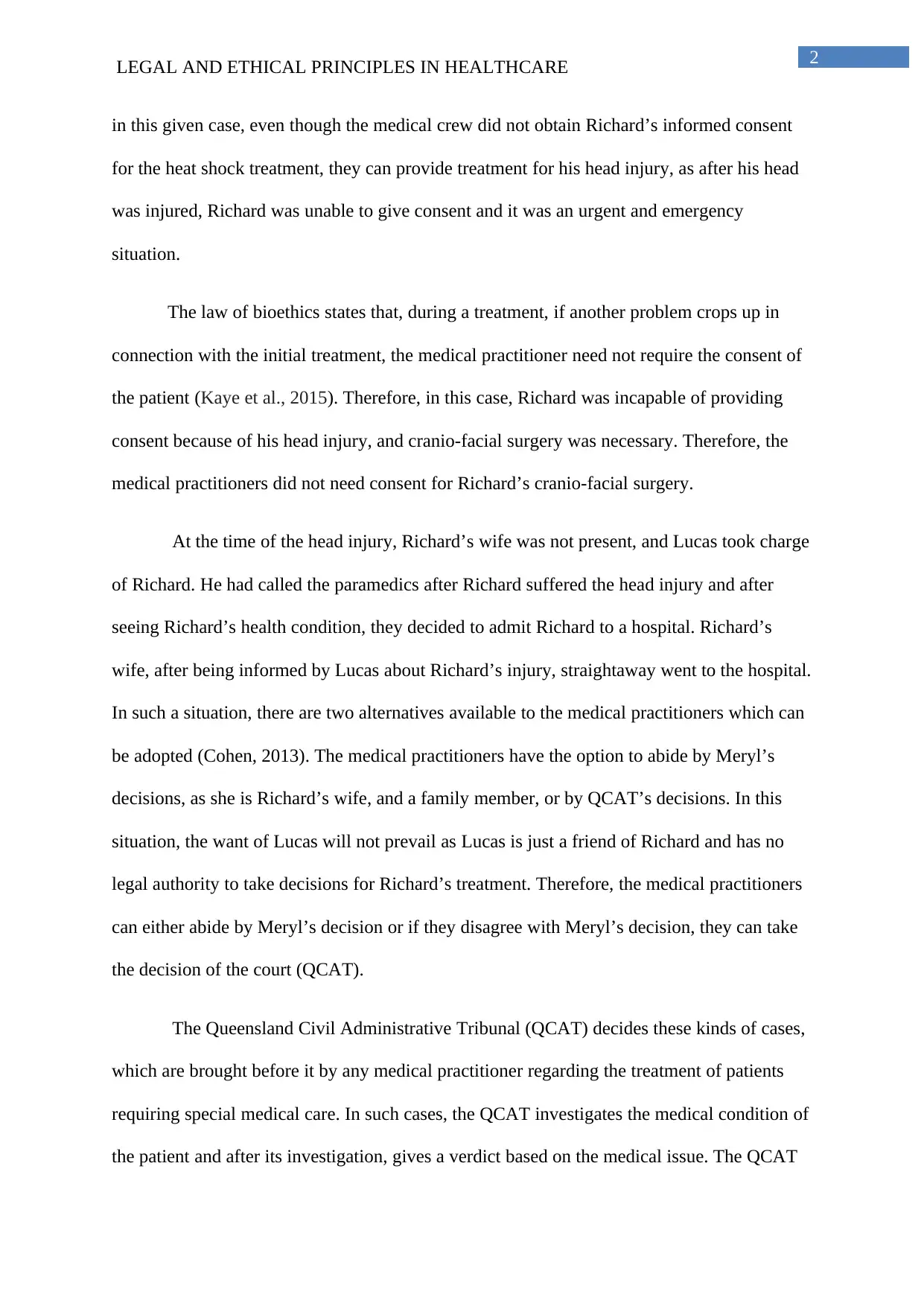
2
LEGAL AND ETHICAL PRINCIPLES IN HEALTHCARE
in this given case, even though the medical crew did not obtain Richard’s informed consent
for the heat shock treatment, they can provide treatment for his head injury, as after his head
was injured, Richard was unable to give consent and it was an urgent and emergency
situation.
The law of bioethics states that, during a treatment, if another problem crops up in
connection with the initial treatment, the medical practitioner need not require the consent of
the patient (Kaye et al., 2015). Therefore, in this case, Richard was incapable of providing
consent because of his head injury, and cranio-facial surgery was necessary. Therefore, the
medical practitioners did not need consent for Richard’s cranio-facial surgery.
At the time of the head injury, Richard’s wife was not present, and Lucas took charge
of Richard. He had called the paramedics after Richard suffered the head injury and after
seeing Richard’s health condition, they decided to admit Richard to a hospital. Richard’s
wife, after being informed by Lucas about Richard’s injury, straightaway went to the hospital.
In such a situation, there are two alternatives available to the medical practitioners which can
be adopted (Cohen, 2013). The medical practitioners have the option to abide by Meryl’s
decisions, as she is Richard’s wife, and a family member, or by QCAT’s decisions. In this
situation, the want of Lucas will not prevail as Lucas is just a friend of Richard and has no
legal authority to take decisions for Richard’s treatment. Therefore, the medical practitioners
can either abide by Meryl’s decision or if they disagree with Meryl’s decision, they can take
the decision of the court (QCAT).
The Queensland Civil Administrative Tribunal (QCAT) decides these kinds of cases,
which are brought before it by any medical practitioner regarding the treatment of patients
requiring special medical care. In such cases, the QCAT investigates the medical condition of
the patient and after its investigation, gives a verdict based on the medical issue. The QCAT
LEGAL AND ETHICAL PRINCIPLES IN HEALTHCARE
in this given case, even though the medical crew did not obtain Richard’s informed consent
for the heat shock treatment, they can provide treatment for his head injury, as after his head
was injured, Richard was unable to give consent and it was an urgent and emergency
situation.
The law of bioethics states that, during a treatment, if another problem crops up in
connection with the initial treatment, the medical practitioner need not require the consent of
the patient (Kaye et al., 2015). Therefore, in this case, Richard was incapable of providing
consent because of his head injury, and cranio-facial surgery was necessary. Therefore, the
medical practitioners did not need consent for Richard’s cranio-facial surgery.
At the time of the head injury, Richard’s wife was not present, and Lucas took charge
of Richard. He had called the paramedics after Richard suffered the head injury and after
seeing Richard’s health condition, they decided to admit Richard to a hospital. Richard’s
wife, after being informed by Lucas about Richard’s injury, straightaway went to the hospital.
In such a situation, there are two alternatives available to the medical practitioners which can
be adopted (Cohen, 2013). The medical practitioners have the option to abide by Meryl’s
decisions, as she is Richard’s wife, and a family member, or by QCAT’s decisions. In this
situation, the want of Lucas will not prevail as Lucas is just a friend of Richard and has no
legal authority to take decisions for Richard’s treatment. Therefore, the medical practitioners
can either abide by Meryl’s decision or if they disagree with Meryl’s decision, they can take
the decision of the court (QCAT).
The Queensland Civil Administrative Tribunal (QCAT) decides these kinds of cases,
which are brought before it by any medical practitioner regarding the treatment of patients
requiring special medical care. In such cases, the QCAT investigates the medical condition of
the patient and after its investigation, gives a verdict based on the medical issue. The QCAT
⊘ This is a preview!⊘
Do you want full access?
Subscribe today to unlock all pages.

Trusted by 1+ million students worldwide
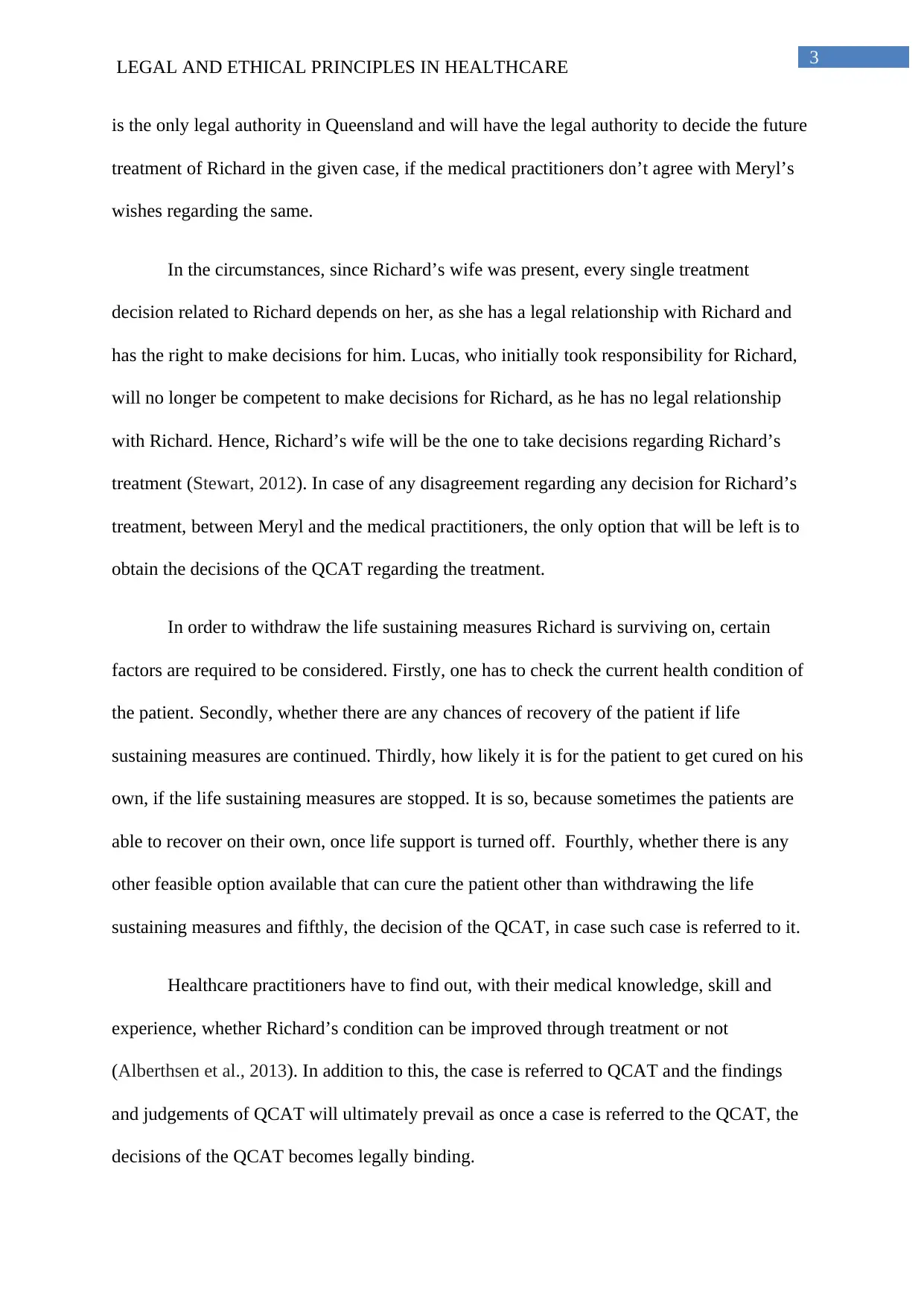
3
LEGAL AND ETHICAL PRINCIPLES IN HEALTHCARE
is the only legal authority in Queensland and will have the legal authority to decide the future
treatment of Richard in the given case, if the medical practitioners don’t agree with Meryl’s
wishes regarding the same.
In the circumstances, since Richard’s wife was present, every single treatment
decision related to Richard depends on her, as she has a legal relationship with Richard and
has the right to make decisions for him. Lucas, who initially took responsibility for Richard,
will no longer be competent to make decisions for Richard, as he has no legal relationship
with Richard. Hence, Richard’s wife will be the one to take decisions regarding Richard’s
treatment (Stewart, 2012). In case of any disagreement regarding any decision for Richard’s
treatment, between Meryl and the medical practitioners, the only option that will be left is to
obtain the decisions of the QCAT regarding the treatment.
In order to withdraw the life sustaining measures Richard is surviving on, certain
factors are required to be considered. Firstly, one has to check the current health condition of
the patient. Secondly, whether there are any chances of recovery of the patient if life
sustaining measures are continued. Thirdly, how likely it is for the patient to get cured on his
own, if the life sustaining measures are stopped. It is so, because sometimes the patients are
able to recover on their own, once life support is turned off. Fourthly, whether there is any
other feasible option available that can cure the patient other than withdrawing the life
sustaining measures and fifthly, the decision of the QCAT, in case such case is referred to it.
Healthcare practitioners have to find out, with their medical knowledge, skill and
experience, whether Richard’s condition can be improved through treatment or not
(Alberthsen et al., 2013). In addition to this, the case is referred to QCAT and the findings
and judgements of QCAT will ultimately prevail as once a case is referred to the QCAT, the
decisions of the QCAT becomes legally binding.
LEGAL AND ETHICAL PRINCIPLES IN HEALTHCARE
is the only legal authority in Queensland and will have the legal authority to decide the future
treatment of Richard in the given case, if the medical practitioners don’t agree with Meryl’s
wishes regarding the same.
In the circumstances, since Richard’s wife was present, every single treatment
decision related to Richard depends on her, as she has a legal relationship with Richard and
has the right to make decisions for him. Lucas, who initially took responsibility for Richard,
will no longer be competent to make decisions for Richard, as he has no legal relationship
with Richard. Hence, Richard’s wife will be the one to take decisions regarding Richard’s
treatment (Stewart, 2012). In case of any disagreement regarding any decision for Richard’s
treatment, between Meryl and the medical practitioners, the only option that will be left is to
obtain the decisions of the QCAT regarding the treatment.
In order to withdraw the life sustaining measures Richard is surviving on, certain
factors are required to be considered. Firstly, one has to check the current health condition of
the patient. Secondly, whether there are any chances of recovery of the patient if life
sustaining measures are continued. Thirdly, how likely it is for the patient to get cured on his
own, if the life sustaining measures are stopped. It is so, because sometimes the patients are
able to recover on their own, once life support is turned off. Fourthly, whether there is any
other feasible option available that can cure the patient other than withdrawing the life
sustaining measures and fifthly, the decision of the QCAT, in case such case is referred to it.
Healthcare practitioners have to find out, with their medical knowledge, skill and
experience, whether Richard’s condition can be improved through treatment or not
(Alberthsen et al., 2013). In addition to this, the case is referred to QCAT and the findings
and judgements of QCAT will ultimately prevail as once a case is referred to the QCAT, the
decisions of the QCAT becomes legally binding.
Paraphrase This Document
Need a fresh take? Get an instant paraphrase of this document with our AI Paraphraser
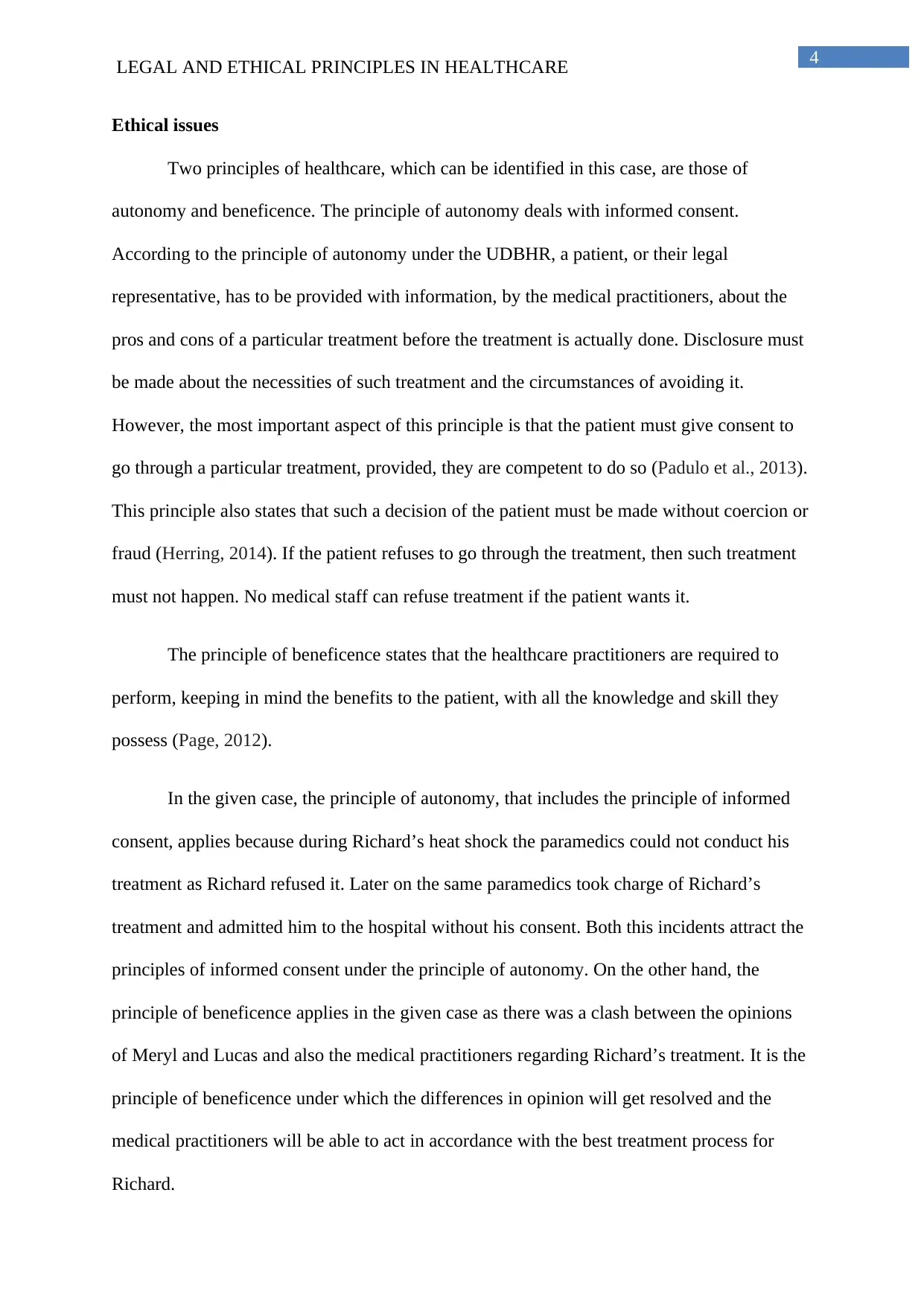
4
LEGAL AND ETHICAL PRINCIPLES IN HEALTHCARE
Ethical issues
Two principles of healthcare, which can be identified in this case, are those of
autonomy and beneficence. The principle of autonomy deals with informed consent.
According to the principle of autonomy under the UDBHR, a patient, or their legal
representative, has to be provided with information, by the medical practitioners, about the
pros and cons of a particular treatment before the treatment is actually done. Disclosure must
be made about the necessities of such treatment and the circumstances of avoiding it.
However, the most important aspect of this principle is that the patient must give consent to
go through a particular treatment, provided, they are competent to do so (Padulo et al., 2013).
This principle also states that such a decision of the patient must be made without coercion or
fraud (Herring, 2014). If the patient refuses to go through the treatment, then such treatment
must not happen. No medical staff can refuse treatment if the patient wants it.
The principle of beneficence states that the healthcare practitioners are required to
perform, keeping in mind the benefits to the patient, with all the knowledge and skill they
possess (Page, 2012).
In the given case, the principle of autonomy, that includes the principle of informed
consent, applies because during Richard’s heat shock the paramedics could not conduct his
treatment as Richard refused it. Later on the same paramedics took charge of Richard’s
treatment and admitted him to the hospital without his consent. Both this incidents attract the
principles of informed consent under the principle of autonomy. On the other hand, the
principle of beneficence applies in the given case as there was a clash between the opinions
of Meryl and Lucas and also the medical practitioners regarding Richard’s treatment. It is the
principle of beneficence under which the differences in opinion will get resolved and the
medical practitioners will be able to act in accordance with the best treatment process for
Richard.
LEGAL AND ETHICAL PRINCIPLES IN HEALTHCARE
Ethical issues
Two principles of healthcare, which can be identified in this case, are those of
autonomy and beneficence. The principle of autonomy deals with informed consent.
According to the principle of autonomy under the UDBHR, a patient, or their legal
representative, has to be provided with information, by the medical practitioners, about the
pros and cons of a particular treatment before the treatment is actually done. Disclosure must
be made about the necessities of such treatment and the circumstances of avoiding it.
However, the most important aspect of this principle is that the patient must give consent to
go through a particular treatment, provided, they are competent to do so (Padulo et al., 2013).
This principle also states that such a decision of the patient must be made without coercion or
fraud (Herring, 2014). If the patient refuses to go through the treatment, then such treatment
must not happen. No medical staff can refuse treatment if the patient wants it.
The principle of beneficence states that the healthcare practitioners are required to
perform, keeping in mind the benefits to the patient, with all the knowledge and skill they
possess (Page, 2012).
In the given case, the principle of autonomy, that includes the principle of informed
consent, applies because during Richard’s heat shock the paramedics could not conduct his
treatment as Richard refused it. Later on the same paramedics took charge of Richard’s
treatment and admitted him to the hospital without his consent. Both this incidents attract the
principles of informed consent under the principle of autonomy. On the other hand, the
principle of beneficence applies in the given case as there was a clash between the opinions
of Meryl and Lucas and also the medical practitioners regarding Richard’s treatment. It is the
principle of beneficence under which the differences in opinion will get resolved and the
medical practitioners will be able to act in accordance with the best treatment process for
Richard.
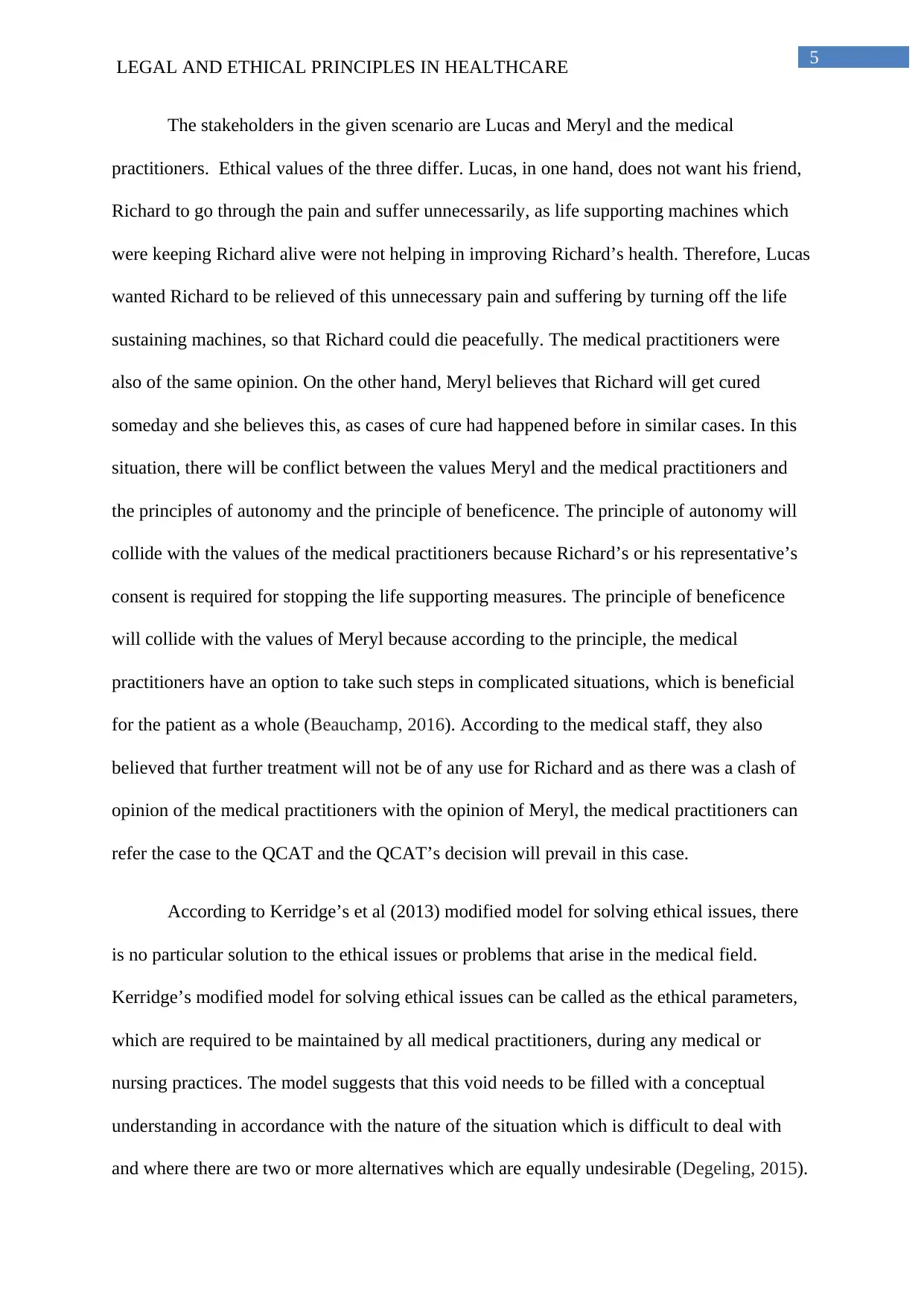
5
LEGAL AND ETHICAL PRINCIPLES IN HEALTHCARE
The stakeholders in the given scenario are Lucas and Meryl and the medical
practitioners. Ethical values of the three differ. Lucas, in one hand, does not want his friend,
Richard to go through the pain and suffer unnecessarily, as life supporting machines which
were keeping Richard alive were not helping in improving Richard’s health. Therefore, Lucas
wanted Richard to be relieved of this unnecessary pain and suffering by turning off the life
sustaining machines, so that Richard could die peacefully. The medical practitioners were
also of the same opinion. On the other hand, Meryl believes that Richard will get cured
someday and she believes this, as cases of cure had happened before in similar cases. In this
situation, there will be conflict between the values Meryl and the medical practitioners and
the principles of autonomy and the principle of beneficence. The principle of autonomy will
collide with the values of the medical practitioners because Richard’s or his representative’s
consent is required for stopping the life supporting measures. The principle of beneficence
will collide with the values of Meryl because according to the principle, the medical
practitioners have an option to take such steps in complicated situations, which is beneficial
for the patient as a whole (Beauchamp, 2016). According to the medical staff, they also
believed that further treatment will not be of any use for Richard and as there was a clash of
opinion of the medical practitioners with the opinion of Meryl, the medical practitioners can
refer the case to the QCAT and the QCAT’s decision will prevail in this case.
According to Kerridge’s et al (2013) modified model for solving ethical issues, there
is no particular solution to the ethical issues or problems that arise in the medical field.
Kerridge’s modified model for solving ethical issues can be called as the ethical parameters,
which are required to be maintained by all medical practitioners, during any medical or
nursing practices. The model suggests that this void needs to be filled with a conceptual
understanding in accordance with the nature of the situation which is difficult to deal with
and where there are two or more alternatives which are equally undesirable (Degeling, 2015).
LEGAL AND ETHICAL PRINCIPLES IN HEALTHCARE
The stakeholders in the given scenario are Lucas and Meryl and the medical
practitioners. Ethical values of the three differ. Lucas, in one hand, does not want his friend,
Richard to go through the pain and suffer unnecessarily, as life supporting machines which
were keeping Richard alive were not helping in improving Richard’s health. Therefore, Lucas
wanted Richard to be relieved of this unnecessary pain and suffering by turning off the life
sustaining machines, so that Richard could die peacefully. The medical practitioners were
also of the same opinion. On the other hand, Meryl believes that Richard will get cured
someday and she believes this, as cases of cure had happened before in similar cases. In this
situation, there will be conflict between the values Meryl and the medical practitioners and
the principles of autonomy and the principle of beneficence. The principle of autonomy will
collide with the values of the medical practitioners because Richard’s or his representative’s
consent is required for stopping the life supporting measures. The principle of beneficence
will collide with the values of Meryl because according to the principle, the medical
practitioners have an option to take such steps in complicated situations, which is beneficial
for the patient as a whole (Beauchamp, 2016). According to the medical staff, they also
believed that further treatment will not be of any use for Richard and as there was a clash of
opinion of the medical practitioners with the opinion of Meryl, the medical practitioners can
refer the case to the QCAT and the QCAT’s decision will prevail in this case.
According to Kerridge’s et al (2013) modified model for solving ethical issues, there
is no particular solution to the ethical issues or problems that arise in the medical field.
Kerridge’s modified model for solving ethical issues can be called as the ethical parameters,
which are required to be maintained by all medical practitioners, during any medical or
nursing practices. The model suggests that this void needs to be filled with a conceptual
understanding in accordance with the nature of the situation which is difficult to deal with
and where there are two or more alternatives which are equally undesirable (Degeling, 2015).
⊘ This is a preview!⊘
Do you want full access?
Subscribe today to unlock all pages.

Trusted by 1+ million students worldwide
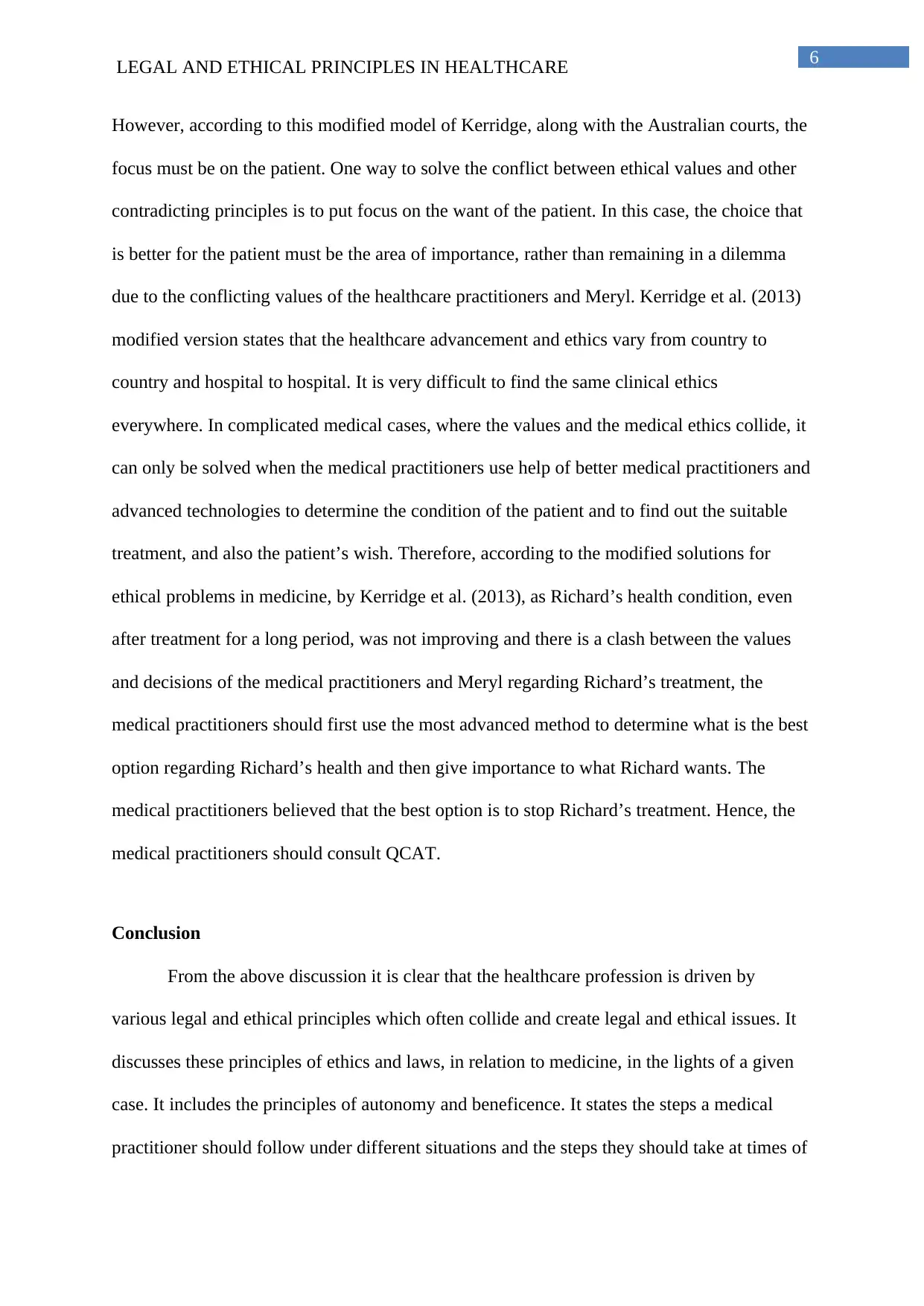
6
LEGAL AND ETHICAL PRINCIPLES IN HEALTHCARE
However, according to this modified model of Kerridge, along with the Australian courts, the
focus must be on the patient. One way to solve the conflict between ethical values and other
contradicting principles is to put focus on the want of the patient. In this case, the choice that
is better for the patient must be the area of importance, rather than remaining in a dilemma
due to the conflicting values of the healthcare practitioners and Meryl. Kerridge et al. (2013)
modified version states that the healthcare advancement and ethics vary from country to
country and hospital to hospital. It is very difficult to find the same clinical ethics
everywhere. In complicated medical cases, where the values and the medical ethics collide, it
can only be solved when the medical practitioners use help of better medical practitioners and
advanced technologies to determine the condition of the patient and to find out the suitable
treatment, and also the patient’s wish. Therefore, according to the modified solutions for
ethical problems in medicine, by Kerridge et al. (2013), as Richard’s health condition, even
after treatment for a long period, was not improving and there is a clash between the values
and decisions of the medical practitioners and Meryl regarding Richard’s treatment, the
medical practitioners should first use the most advanced method to determine what is the best
option regarding Richard’s health and then give importance to what Richard wants. The
medical practitioners believed that the best option is to stop Richard’s treatment. Hence, the
medical practitioners should consult QCAT.
Conclusion
From the above discussion it is clear that the healthcare profession is driven by
various legal and ethical principles which often collide and create legal and ethical issues. It
discusses these principles of ethics and laws, in relation to medicine, in the lights of a given
case. It includes the principles of autonomy and beneficence. It states the steps a medical
practitioner should follow under different situations and the steps they should take at times of
LEGAL AND ETHICAL PRINCIPLES IN HEALTHCARE
However, according to this modified model of Kerridge, along with the Australian courts, the
focus must be on the patient. One way to solve the conflict between ethical values and other
contradicting principles is to put focus on the want of the patient. In this case, the choice that
is better for the patient must be the area of importance, rather than remaining in a dilemma
due to the conflicting values of the healthcare practitioners and Meryl. Kerridge et al. (2013)
modified version states that the healthcare advancement and ethics vary from country to
country and hospital to hospital. It is very difficult to find the same clinical ethics
everywhere. In complicated medical cases, where the values and the medical ethics collide, it
can only be solved when the medical practitioners use help of better medical practitioners and
advanced technologies to determine the condition of the patient and to find out the suitable
treatment, and also the patient’s wish. Therefore, according to the modified solutions for
ethical problems in medicine, by Kerridge et al. (2013), as Richard’s health condition, even
after treatment for a long period, was not improving and there is a clash between the values
and decisions of the medical practitioners and Meryl regarding Richard’s treatment, the
medical practitioners should first use the most advanced method to determine what is the best
option regarding Richard’s health and then give importance to what Richard wants. The
medical practitioners believed that the best option is to stop Richard’s treatment. Hence, the
medical practitioners should consult QCAT.
Conclusion
From the above discussion it is clear that the healthcare profession is driven by
various legal and ethical principles which often collide and create legal and ethical issues. It
discusses these principles of ethics and laws, in relation to medicine, in the lights of a given
case. It includes the principles of autonomy and beneficence. It states the steps a medical
practitioner should follow under different situations and the steps they should take at times of
Paraphrase This Document
Need a fresh take? Get an instant paraphrase of this document with our AI Paraphraser
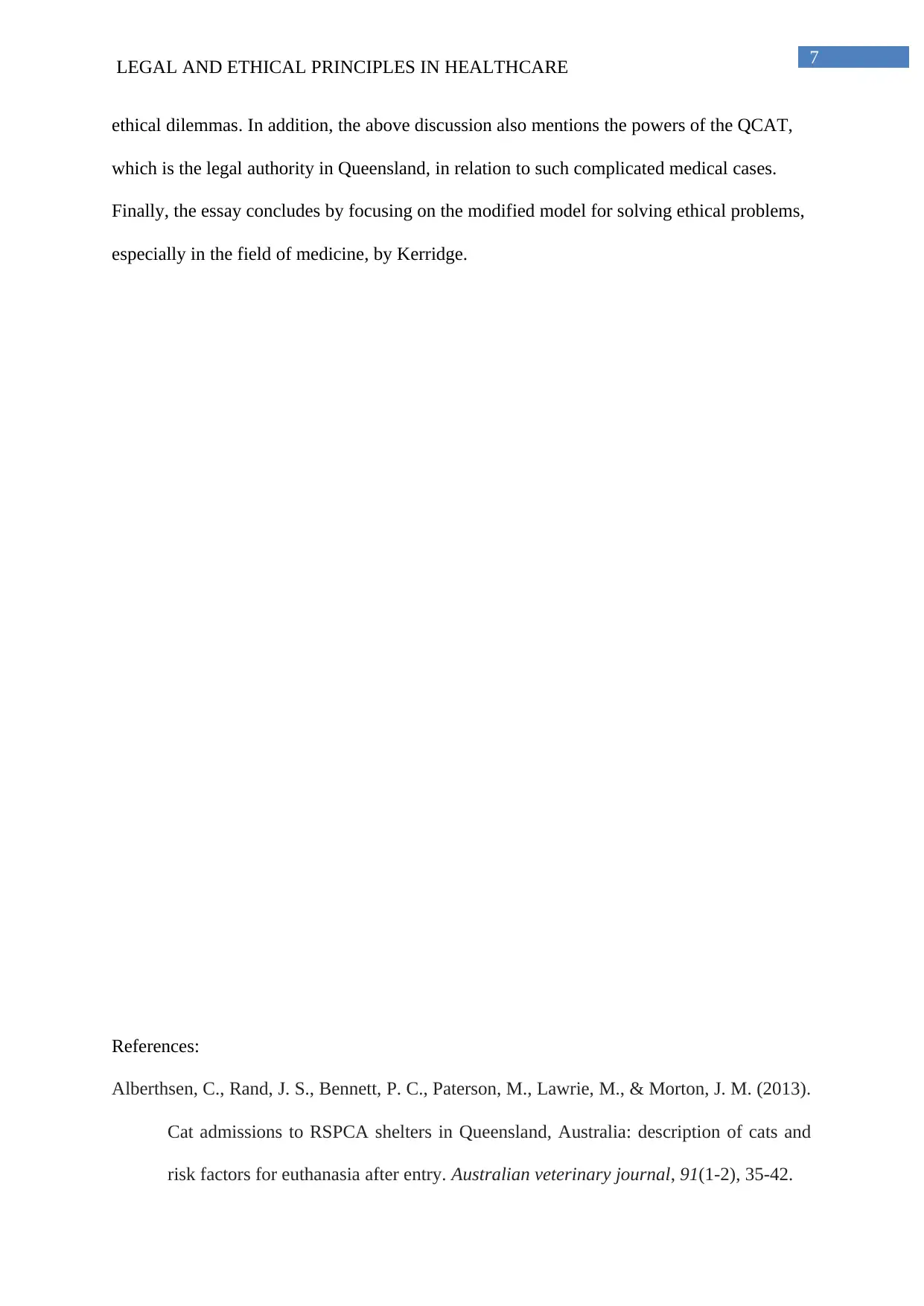
7
LEGAL AND ETHICAL PRINCIPLES IN HEALTHCARE
ethical dilemmas. In addition, the above discussion also mentions the powers of the QCAT,
which is the legal authority in Queensland, in relation to such complicated medical cases.
Finally, the essay concludes by focusing on the modified model for solving ethical problems,
especially in the field of medicine, by Kerridge.
References:
Alberthsen, C., Rand, J. S., Bennett, P. C., Paterson, M., Lawrie, M., & Morton, J. M. (2013).
Cat admissions to RSPCA shelters in Queensland, Australia: description of cats and
risk factors for euthanasia after entry. Australian veterinary journal, 91(1-2), 35-42.
LEGAL AND ETHICAL PRINCIPLES IN HEALTHCARE
ethical dilemmas. In addition, the above discussion also mentions the powers of the QCAT,
which is the legal authority in Queensland, in relation to such complicated medical cases.
Finally, the essay concludes by focusing on the modified model for solving ethical problems,
especially in the field of medicine, by Kerridge.
References:
Alberthsen, C., Rand, J. S., Bennett, P. C., Paterson, M., Lawrie, M., & Morton, J. M. (2013).
Cat admissions to RSPCA shelters in Queensland, Australia: description of cats and
risk factors for euthanasia after entry. Australian veterinary journal, 91(1-2), 35-42.
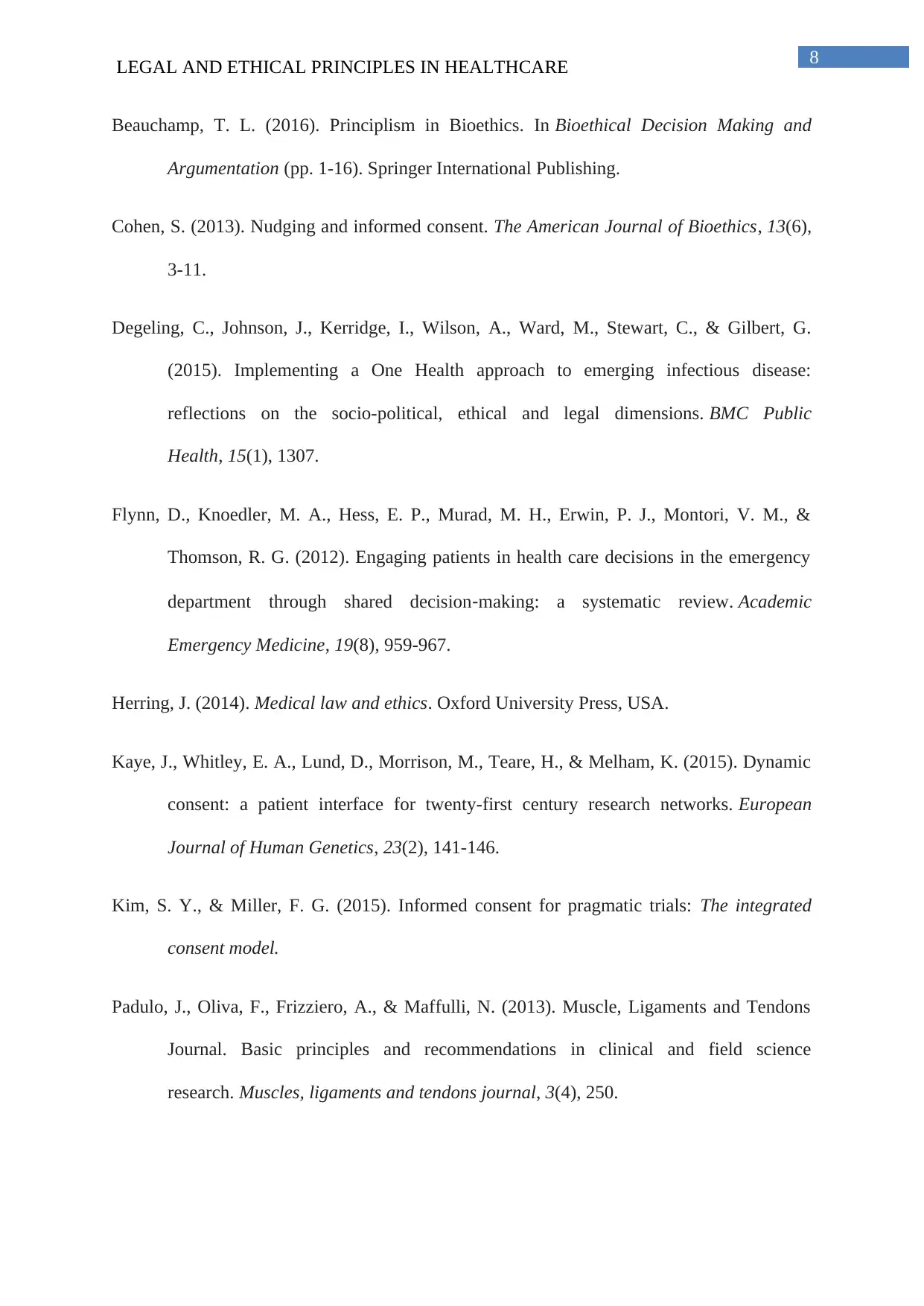
8
LEGAL AND ETHICAL PRINCIPLES IN HEALTHCARE
Beauchamp, T. L. (2016). Principlism in Bioethics. In Bioethical Decision Making and
Argumentation (pp. 1-16). Springer International Publishing.
Cohen, S. (2013). Nudging and informed consent. The American Journal of Bioethics, 13(6),
3-11.
Degeling, C., Johnson, J., Kerridge, I., Wilson, A., Ward, M., Stewart, C., & Gilbert, G.
(2015). Implementing a One Health approach to emerging infectious disease:
reflections on the socio-political, ethical and legal dimensions. BMC Public
Health, 15(1), 1307.
Flynn, D., Knoedler, M. A., Hess, E. P., Murad, M. H., Erwin, P. J., Montori, V. M., &
Thomson, R. G. (2012). Engaging patients in health care decisions in the emergency
department through shared decision‐making: a systematic review. Academic
Emergency Medicine, 19(8), 959-967.
Herring, J. (2014). Medical law and ethics. Oxford University Press, USA.
Kaye, J., Whitley, E. A., Lund, D., Morrison, M., Teare, H., & Melham, K. (2015). Dynamic
consent: a patient interface for twenty-first century research networks. European
Journal of Human Genetics, 23(2), 141-146.
Kim, S. Y., & Miller, F. G. (2015). Informed consent for pragmatic trials: The integrated
consent model.
Padulo, J., Oliva, F., Frizziero, A., & Maffulli, N. (2013). Muscle, Ligaments and Tendons
Journal. Basic principles and recommendations in clinical and field science
research. Muscles, ligaments and tendons journal, 3(4), 250.
LEGAL AND ETHICAL PRINCIPLES IN HEALTHCARE
Beauchamp, T. L. (2016). Principlism in Bioethics. In Bioethical Decision Making and
Argumentation (pp. 1-16). Springer International Publishing.
Cohen, S. (2013). Nudging and informed consent. The American Journal of Bioethics, 13(6),
3-11.
Degeling, C., Johnson, J., Kerridge, I., Wilson, A., Ward, M., Stewart, C., & Gilbert, G.
(2015). Implementing a One Health approach to emerging infectious disease:
reflections on the socio-political, ethical and legal dimensions. BMC Public
Health, 15(1), 1307.
Flynn, D., Knoedler, M. A., Hess, E. P., Murad, M. H., Erwin, P. J., Montori, V. M., &
Thomson, R. G. (2012). Engaging patients in health care decisions in the emergency
department through shared decision‐making: a systematic review. Academic
Emergency Medicine, 19(8), 959-967.
Herring, J. (2014). Medical law and ethics. Oxford University Press, USA.
Kaye, J., Whitley, E. A., Lund, D., Morrison, M., Teare, H., & Melham, K. (2015). Dynamic
consent: a patient interface for twenty-first century research networks. European
Journal of Human Genetics, 23(2), 141-146.
Kim, S. Y., & Miller, F. G. (2015). Informed consent for pragmatic trials: The integrated
consent model.
Padulo, J., Oliva, F., Frizziero, A., & Maffulli, N. (2013). Muscle, Ligaments and Tendons
Journal. Basic principles and recommendations in clinical and field science
research. Muscles, ligaments and tendons journal, 3(4), 250.
⊘ This is a preview!⊘
Do you want full access?
Subscribe today to unlock all pages.

Trusted by 1+ million students worldwide
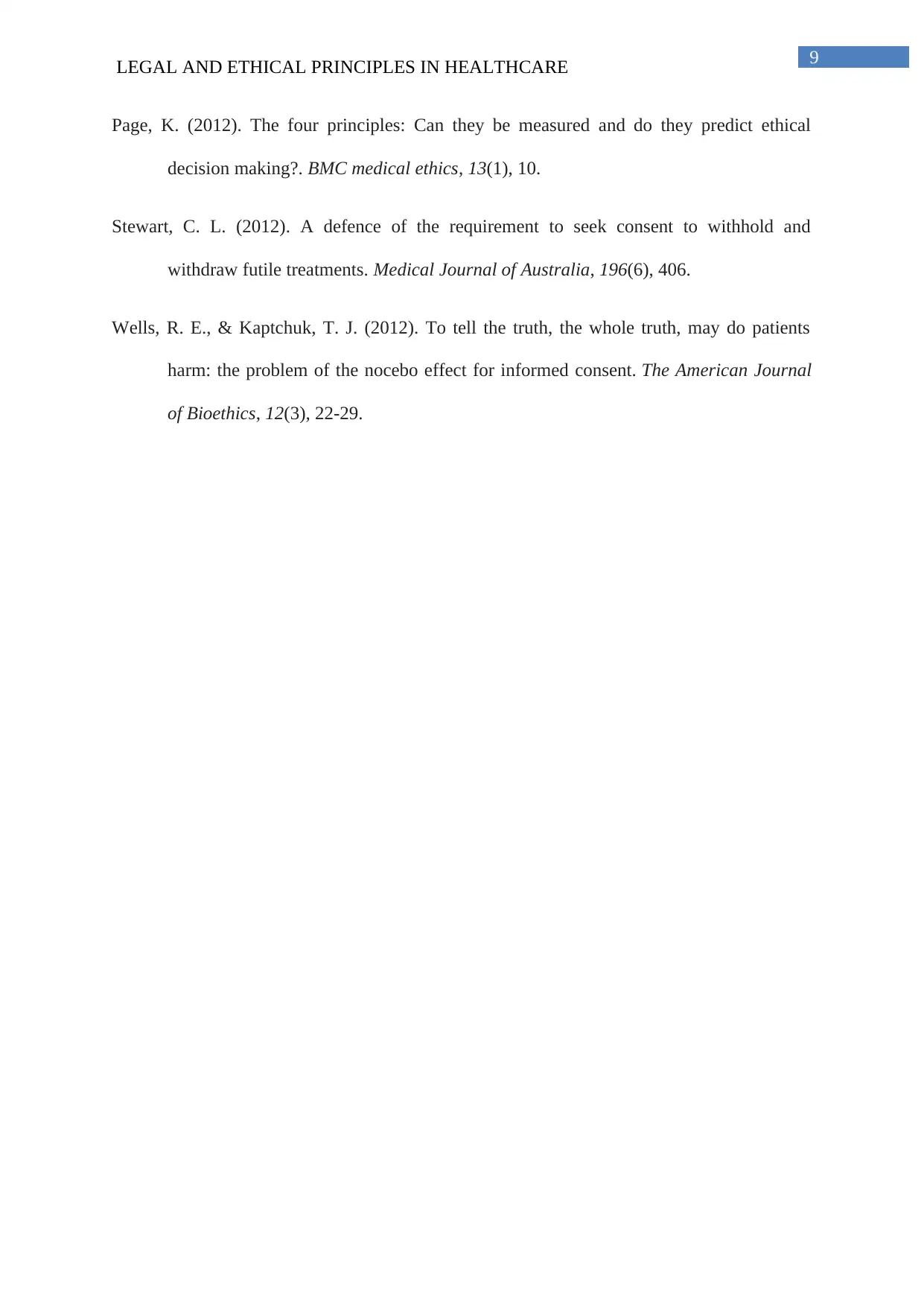
9
LEGAL AND ETHICAL PRINCIPLES IN HEALTHCARE
Page, K. (2012). The four principles: Can they be measured and do they predict ethical
decision making?. BMC medical ethics, 13(1), 10.
Stewart, C. L. (2012). A defence of the requirement to seek consent to withhold and
withdraw futile treatments. Medical Journal of Australia, 196(6), 406.
Wells, R. E., & Kaptchuk, T. J. (2012). To tell the truth, the whole truth, may do patients
harm: the problem of the nocebo effect for informed consent. The American Journal
of Bioethics, 12(3), 22-29.
LEGAL AND ETHICAL PRINCIPLES IN HEALTHCARE
Page, K. (2012). The four principles: Can they be measured and do they predict ethical
decision making?. BMC medical ethics, 13(1), 10.
Stewart, C. L. (2012). A defence of the requirement to seek consent to withhold and
withdraw futile treatments. Medical Journal of Australia, 196(6), 406.
Wells, R. E., & Kaptchuk, T. J. (2012). To tell the truth, the whole truth, may do patients
harm: the problem of the nocebo effect for informed consent. The American Journal
of Bioethics, 12(3), 22-29.
1 out of 10
Related Documents
Your All-in-One AI-Powered Toolkit for Academic Success.
+13062052269
info@desklib.com
Available 24*7 on WhatsApp / Email
![[object Object]](/_next/static/media/star-bottom.7253800d.svg)
Unlock your academic potential
Copyright © 2020–2025 A2Z Services. All Rights Reserved. Developed and managed by ZUCOL.





